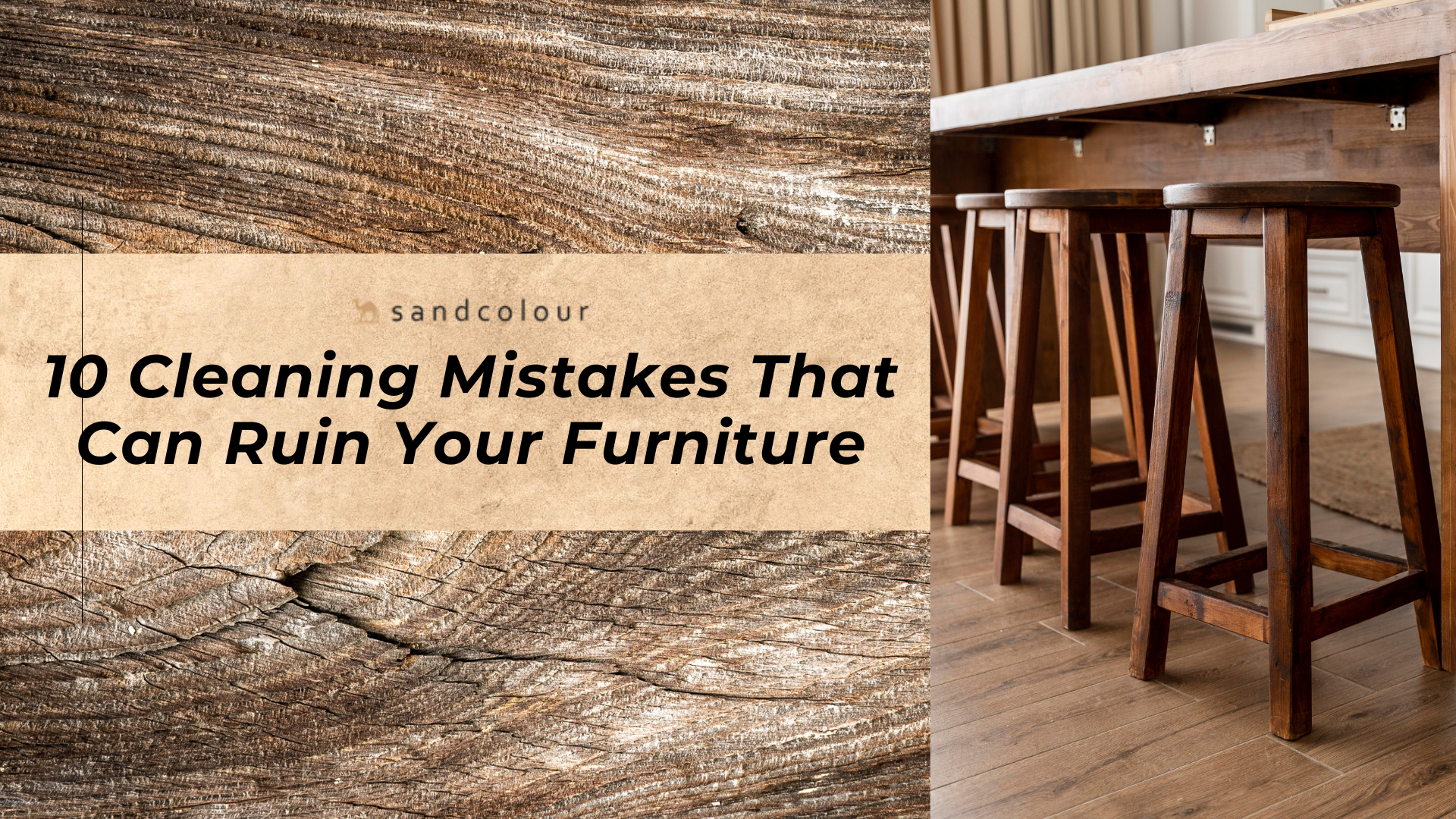10 Cleaning Mistakes That Can Ruin Your Furniture

Your furniture is an investment which makes your house complete in terms of character, comfort and value. Be it an antique dining table made of wood, a velvet sofa or a classy armchair made of leather, frequent cleaning leaves your pieces beautiful to look at and makes them last longer. Nevertheless, most individuals actually destroy their furniture without even knowing how to take care of it.
We will look at 10 mistakes that you are likely to make, and that can destroy your furniture, in this article, and will also provide some academic ideas to avoid them. In case you plan to keep your pieces in service and maintain their design, continue reading.
1. Application of Harsh Chemical Cleaners
Among the greatest cleaning errors the owners of houses make is pollution of strong chemical cleaners, not to mention those that are not meant to be used on furniture. Filters can be stripped off, threads can be washed out, and permanent stains may be created by products that include such elements as ammonia, bleach or alcohol.
Caring Tip: Never forget to read the label. Occasionally clean with gentle furniture cleaners or make your own soap with vinegar, a mild soap or warm water and a little mild soap. In the case of wooden items, you should use oil-based cleaners that would feed the wood without harming its colouring.
2. Upholstery and Cushions Over-Wetting Upholstery and Cushions
Water is not always a friend. When fabrics get too much water as part of cleaning, you can get mildew and a bad odour; in severe cases, the underlying frames may get warped, particularly with wooden pieces in your furniture.
Caring Tip: spot clean with a dripping, but not drenching, cloth. Blot when you do not need to scrub. During the deep cleaning, the minimum moisture is to be used, and the fans or ventilation should be ensured in order to dry up.
3. This is not dusting regularly
This might not sound like a crime, but by allowing dust to deposit on the furniture, especially the wood and leather furniture, it might result in the production of small scratches and dullness, as well as the attraction of mites. With time, dust accumulates and penetrates fissures and destroys material.
Caring Tip: Dust once a week with a soft micro fibre cloth or with a feather duster. Scrubbed or cut work may be done with a soft brush or vacuum with a brush attachment.
4. Spills and Stains Ignorance
An expeditious course to the permanent injury is to leave spills to settle. As an example of the liquid, there are wine, juice, or coffee, which can stain the fabric and wood. Once they are absorbed, then grease stains are even more difficult to remove.
Caring Tip: Clear up spills as soon as they occur. Gently blot (but never rub) with a fresh cloth. In the case of tough stains, apply stain removers that are not harmful to fabrics or wood. Always do a test on a non-visible part first.
5. Excess Polish or Waxing
Although a little polishing is good to maintain gloss, over-applying wax or polish would result in a buildup, which may result in sticky residue, entailing more dust and dirt. Such accumulation also has the effect of dulling the finish over the years.
Caring Tip: You do not need to polish your furniture more frequently than a few times a year, and you should always read the instructions on the product you are going to use. Wipe the shine out using a soft and clean cloth, and then lightly buff.
6. Instead of cleaning softly, scrubbing is done
Rough scrubbing, particularly on the fabrics which are delicate, painted wood, or leather, may remove the finishes, abrade the fibres, or produce stains. Rubbing the stain really hard will also embed the stain further into the metal.
Caring Tip: You should never be harsh. Blot, wipe or dab. Allow cleaning products to stand for a little while to remove the dirt in a natural way rather than through force.
7. Failure to follow the instructions of the Manufacturer
All the pieces of furniture are manufactured and come in a variety of materials. The failure to follow the care instructions may result in the wrong method or product being used, which may result in irreparable damage.
Caring Tip: Retain supply labels or user guides. Remember to take proper care (the same goes especially with pretty or designer pieces). In case of suspicion, contact the manufacturer or call the professional cleaner.
8. Putting Furniture in the Direct Sunlight
This was not exactly a cleaning error, but all the cleanup efforts may be wasted when you put your furniture back under intense heat in the sun. Lighter colours are also subject to fading due to UV rays, leather can be dried out, and items of wood can also crack.
Caring Tip: Arrange the furniture in areas where sunlight is not directly hitting the furniture, or you can use curtains and blinds. In the case of wooden and leather furniture, use UV-protective coats or conditioners frequently.
9. Failure to use the Correct Tools
Abrasive scrubbers, coarse cloths, and even vacuum attachments without the special brushes can scratch, tear or leave marks.
Caring Tip: it is okay to clean cushions with the soft-bristle brushes, microfibre cloths and vacuum devices with upholstery-safe headings. Do not use scouring pads or anything that can scratch or tear at the surface of your furniture.
10. Neglect of Routine Maintenance
Some individuals only take care of their furniture when they see that there is some form of dirt or destruction, but it is usually too late. Failure to carry out maintenance tasks reduces the furniture's life, and future cleaning becomes harder.
Caring Tip: Establish a maintenance checklist once a month. Frequently wipe away dust, vacuum fabrics, look over signs of moisture, wax timber items, and recreate the leather. Little consistent efforts will take you a long way towards the beauty of your furniture.
Extra Long-lasting Furniture Touch-ups
Turn cushions and pillows so they do not wear out unevenly.
Put protective covers on the bottom of vessels or hot objects on tables.
You should invest in seasonal covers to protect the outdoor furniture.
Avoid having pets on very delicate fabrics.
-
Q: Is it possible to clean all kinds of furniture with vinegar?
A: Vinegar is fine on most surfaces, but not on waxed wood or on untreated stone. Always mix it and make a test on a small area. -
Q: What is the frequency of deep-cleaning of my upholstered furniture?
A: It is best to do it once in 6-12 months. In families with children or pet animals, it can be preferable to do it after 3 to 6 months. -
Q. What is the safest method to clean leather furniture?
A: To clean, take a dry piece of cloth and dust with it, then take another wet cloth and remove stains. With the help of leather conditioner, it is recommended to use it every two months or so to avoid drying or cracking.




